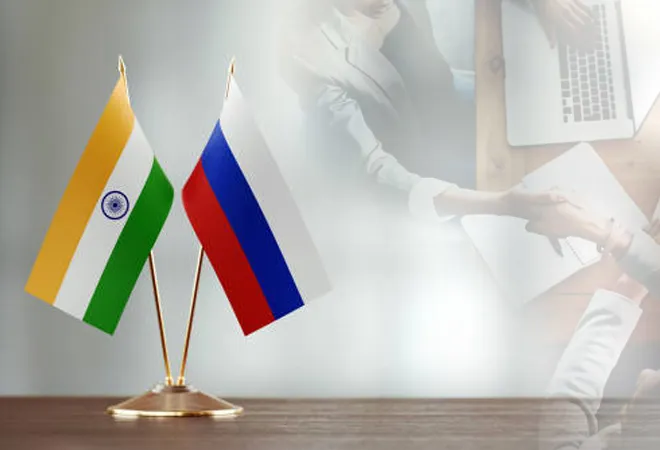
The past
Since India gained independence, its relationship with Russia had always been cordial. However, bilateral business has been undergoing a deep transformation, a function of domestic transformations in India and Russia since the 1980s. Most of the legacy businesses died save for a few niches, but there are green shoots that are promising.
In its communist past, Russia had made enormous contributions to India’s infrastructure—built hydro power stations, steel plants, defence factories, and gave many Indians world-class educational and knowledge exchanges in multiple areas. The cultural imprint of the friendship of our nations is deep rooted in both countries.
Whatever agenda the erstwhile USSR pursued in India after it gained independence had been increasingly lost since its collapse. In the past 30 years, only a handful of successful bilateral trade avenues and successful projects remain and continue their evolution. It’s not much to speak of compared to the economic relationships between India’s and Russia’s largest trading partners—the United States and China, respectively.
India is known not only for its robust pharmaceuticals sector, but also for its Business Process Outsourcing (BPO) industry, and technology sector leadership.
But what’s beyond this? Why does bilateral trade still hover around the US $10 billion mark? Why are bilateral investments far below their potential? There are several reasons for this behaviour—national and global interests, domestic agenda, lack of problem-solving focus from governments, priorities, regulations, perceptions, choice of friends and allies, short-sightedness, and free markets.
Despite the similarities, the countries could not have been more different in terms of demographics, growth drivers, import/export mix, or per capita income. Despite common dismissive views of India by Russia and Russians, all of a sudden India finds itself ahead of Russia in many categories. Today, India is known not only for its robust pharmaceuticals sector, but also for its Business Process Outsourcing (BPO) industry, and technology sector leadership.
In current US dollars terms, India outgrew Russia x5.4 to x4.8 since 2001, when Jim O’Neill coined the term ‘BRICS’. This may not seem much, but graphics show a diverging trajectory. In 2011, Russia still maintained the lead in GDP over India, but in 2020 Russia’s GDP is almost twice as small as India’s.

For all the progress of Russia in terms of capital markets development, its market capitalisation has been stagnating. Some bright spots emerged in the form of Individual Investment Accounts and ability to buy/sell shares in a growing number of foreign companies, like Apple and Intel.

Projected fiscal deficits (percentage of GDP) for Russia and India in the current financial year are 2.4 percent and 6.8 percent, respectively. Russia’s conservative policy seems to be working so well, that its Finance Minister recently said that it’s likely to be a mere 1 percent at year end. India, on the other hand, had been persistently running a fiscal deficit. Russia is much more efficient at tax collection. Yet the numbers, as reported in August by both governments, show different quality of growth, particularly in core sectors. April-June Quarter of 2021 economic results are reflective of the divergent paths of both countries:
| Indicator |
Russia |
India |
| GDP Growth, percent |
10.3% |
20.1% |
| Construction sector growth |
10.7% |
68.3% |
| Manufacturing sector growth |
11.4% |
49.6% |
| Mining sector growth |
7.8% |
18.6% |
Despite the differences, the needs and interests of India and Russia are similar: Human development, infrastructure, and wealth creation. These are the convergent areas where focus of the bilateral relations should be re-targeted. We lost a lot of ground in the 30 years since the USSR broke down. It is about time our common interests are rediscovered and acted upon responsibly.
The brick-and-mortar present
Change is like Taiga (the relic, untouched forests, which cover Siberian Russia), a gust of wind will make a few pine cones (e.g. bureaucrats) drop down and the Taiga goes back to its eternal stillness. MOUs are similar to that. They just rustle a few leaves and don’t amount to much. They are unrealised options that expire without being exercised, destroying their value and good intent. A good example is the recent MOU on a bilateral investment fund between Russian Direct Investment Fund (RDIF) and the State Bank of India (SBI)—it got dissolved before accomplishing much.

There is not much to speak of in terms of sustainable link in trade except defence, pharma, and fertilisers. Engineering is pretty much limited to Atomstroyexport’s Kudankulam nuclear power station in Chennai. Joint Ventures (JV) are stalled over various issues, and projects are delayed and failed; for instance, MTS India flunked. The only successful joint venture is Brahmos. There are more or less regular fertiliser exports to India and the regular flow of pharmaceuticals imports from India. Many of these drugs were registered when USSR was in existence, and the only recent market entrant is Himalaya, but it exports cosmetics and dietary supplements, hardly any pharma preparations. The only two Russian tech companies doing business in India with success are Kaspersky Labs (IT security) and to some extent Zyfra (industrial automation and AI). Indian IT companies do work for Russian companies outside of Russia, mostly in the BPO space. Infrastructure and engineering companies from Russia are long gone from India, with little work—mostly upgrades at SAIL, which was built with Soviet assistance. Indian companies hardly ever dare to venture into Russia.
Projected fiscal deficits (percentage of GDP) for Russia and India in the current financial year are 2.4 percent and 6.8 percent, respectively.
What are the reasons for this dire state of affairs? We can identify three key ones: Geoeconomic, geopolitical, and competitive reasons; a lack of vision, motivation, and creativity; and, finally, man-made barriers.
India is an intense competitive and geopolitical battleground—for countries and for global and domestic companies aspiring to take advantage of the potential size of the economy and its favourable demographics. Competition is fierce yet there is place for everyone. It’s a good spot to be in; India can choose and use this competition as leverage. Russia has to compete with others and revamp its approach; traditional approaches to bilateral relations simply won’t work. Add to that its neglect and oversight of India as a strategic partner (as compared to China, for example) and there is a large gap to make up.
Indian diplomacy carefully steers the dialogue, but there is a growing perception that there just isn’t much to gain from Russia and its allies compared to the EU, North America, Africa, and GCC. Other factors inflame its uch as sanctions imposed by the EU and the US on Russia and its union partner Belarus, its corporate and individual subjects. The Free Trade Agreement (FTA) between India and Eurasian Economic Union (currently includes Russia, Kazakhstan, Armenia, Belarus, Kyrgyzstan, and Tajikistan) seems to be on the back burner; India is prioritising FTA’s with the likes of Canada, EU, GCC, and Australia.
Indian IT companies do work for Russian companies outside of Russia, mostly in the BPO space.
Then there are man-made barriers: Bureaucratic procedures on both sides in many areas and procurement/contract procedures, domination of G2G dialogue, lack of financial infrastructure and support, corporate governance, rudimentary ways of information flows. Indian scheduled banks don’t have much faith, judging by the size, if at all, of their country limits on Russia and neighbouring countries. Russian banks are more open, but the businesses they support are more conservative. These factors have together contributed to the weak state of India-Russia business ties in the post-Soviet period.
The views expressed above belong to the author(s). ORF research and analyses now available on Telegram! Click here to access our curated content — blogs, longforms and interviews.







 PREV
PREV


